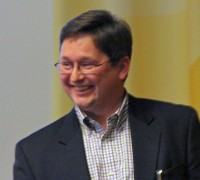For many involved with the ILC, Mark Palmer exemplifies what it means to be a nexus.
Palmer is the connection between the Cornell Electron-Positron Storage Ring Test Accelerator (CesrTA) programme – a prototyping project for the ILC damping ring – and the larger ILC community. Working with his team at home and taking their findings to the Global Design Effort, Palmer devotes as much diligence to writing reports as he does to analysing particle beam data, fitting test results into the framework of collaboration.
“Mark has been a tireless advocate for the CesrTA scientific programme, and is almost singlehandedly responsible for establishing Cornell as the centre of ILC damping ring expertise,” said CesrTA Principal Investigator David Rubin, also leader of the low-emittance tuning group.
A man of many well spoken words, Palmer brings in physicists from outside Cornell for input on CESR data. As an ambassador for CesrTA to the linear collider community, he’s turned many scientists’ attention to Ithaca, New York.
One of the many tasks of CesrTA is to subdue derailing effects known as electron clouds in the accelerator. The electron cloud is not yet fully understood, and modelling it is crucial for the success of future electron-positron colliders. By many accounts, Palmer’s persistence in ploughing through various physics scenarios is responsible for bringing researchers that much closer to handling the problem.
“The CesrTA programme led by Mark Palmer represents a huge step forward by actually measuring and quantifying the effects, as well as comparing mitigation techniques,” said GDE Director Barry Barish. “Mark has led the project by example, being on top of all issues from technical matters to project management.”
Palmer’s dedication to CesrTA springs in part from his regard for CESR as a treasure in the field of accelerator technology.
“In accelerator physics, it is rare to be able to take an operating high-energy physics machine and utilise it for an extensive accelerator physics experimental programme,” Palmer said. “Here at Wilson Lab, we have the combination of a university environment, an operational machine, and very few restrictions on people conducting basic accelerator research. Unique research opportunities have a chance of coming to fruition in an environment like this.”
With such opportunities so close at hand, one can hardly keep them to himself.
“Asked to participate in a review, teach a class, or to consider a test of yet another mitigation, he – almost – never says no,” Rubin said.
That may be because there’s little about physics that doesn’t engage him.
During his final year as a Princeton University undergraduate and under the guidance of Nobel laureate Val Fitch, Palmer set himself to building a torsion balance that would be sensitive to a short-term component of gravity (discussed in a paper by Ephraim Fischbach). After completing a yearlong Fulbright fellowship at Rijksuniversiteit Groningen in the Netherlands, he returned to Princeton for graduate school. He researched so-called fifth force measurements for his doctoral dissertation, also supervised by Fitch.
“I essentially got a gravity-related degree while I was there,” he said. Then, while at the University of Illinois, stronger, shorter-range forces lured him to particle physics. He worked on the CLEO silicon detector project for his post-doctoral research.
“I enjoy the technical, engineering-intensive things,” he said. “There are folks in high-energy physics who enjoy using computers, but I have always tended to be fairly hardware-oriented.”
He became a member of the CLEO Collaboration in 1994, where plenty of hardware and particle puzzles awaited him. In 2000, he joined the accelerator operations group at Cornell and since 2005, has been actively participating in the ILC collaboration, which has allowed him join the study of fundamental physics with the machinery that reveals it.
“It’s been a nice balance of things these last ten years,” he said.
Working at Cornell also allows him to be close to relatives in upstate New York, where his wife, a choir director and elementary school music teacher, grew up and has family. They and their two teen-aged sons maintain a full life of year-round sports, music, and enjoyment of the outdoors, especially with Ithaca’s beloved waterfalls, wild game and sledding slopes.
Though Palmer is meticulous in managing CesrTA, he is not strictly business.
“He’s got a wry sense of humor,” said GDE Americas Regional Director Mike Harrison. And using that sharp tool, he said, “Mark’s able to keep a steady hand on the tiller during the inevitable stormy weather.”



Recent Comments